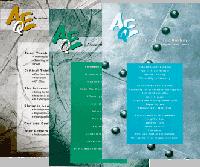On the Origins of Scientific Curiosity

Academic Exchange Quarterly
The following article was published in the Academic Exchange Quarterly during my tenure with the journal as copy editor. Publication information is listed at the end of the essay.
I have required my composition students each semester for the past several years to write research papers on scientists, writing about the scientists' lives, their work, and their impact on society and science. One of my reasons for choosing this topic is to lead students to a better understanding of science and its impact on our lives, and, hopefully, encourage some to seek a career in science. Another reason is my own interest in science, which makes reading seventy student papers about these scientists and their work more a pleasure and less a chore. Frequently, as my students write about these men and women of science, they comment on the early interest in science so many of these scientists had, like Einstein, with his compass, or Edison with his telegraph. This semester two students recounted how young Werner von Braun strapped six fireworks engines to his toy wagon and rocketed through the streets of Berlin until he was arrested by the police. Like von Braun, several young scientists-in-training found themselves in trouble because of their "scientific curiosity."
My own interest in science began in fourth grade. In fifth grade, I was reading Tom Swift stories and science fiction novels by Norton, Del Rey, Silverberg, and others. By sixth grade, I was reading hefty books like the Life Nature Library series and keeping a scrapbook of science articles gleaned from Reader's Digest and Life. By the time I was a teenager, the wall of my bedroom was decorated with a Rand McNally map of the moon. A small telescope and an even smaller microscope lay on my dresser. In the corner of the bedroom sat a battered white metal cabinet my grandmother had kept in her pantry for dry goods. One door was held to its hinge by a makeshift pin, a bent finishing nail. A boy's padlock and chain secured the door. Inside was a carefully arranged collection of chemicals and scientific paraphernalia. What was once a peanut butter jar held four pounds of potassium nitrate, saltpeter purchased in 4 oz. boxes packaged for brining at the drug store three miles away. A glass marshmallow jar was filled to the brim with charcoal, patiently ground from charcoal briquets by my neighbor and fellow scientist, Dennis Myers, while, in the back of the cabinet sat a 3 lb. jar of sulfur, expensive, pharmaceutical grade sulfur, the only sulfur Dennis and I could find locally, purchased in nearby York, Pennsylvania, at a medical supply house. The cabinet smelled of iodine from a small 2 oz. jar whose aluminum lid was slowly being eaten away by the corrosive crystals inside, black-green and shiny like mica. The shelves were stocked with retorts and flasks, test tubes and small vials hoarding the remains of my first chemistry set. A composition book and a black paper folder held the alchemist secrets we had gathered from mail-in ads to Popular Science and Popular Mechanics. A hundred feet of green professional fuse coiled in the corner of a shelf, safely away from any chemicals. An electrical kit I had received one Christmas was arranged on another shelf. I still remember the smell when I opened those doors, a composite of rust and iodine, charcoal and ammonia, all the ingredients of boyhood dreams.
I, too, have a "checkered past." One Good Friday, one of my homemade rockets misfired, resulting in a burning field, a call to the local fire company, and singed hair and eyebrows as I battled to put out the flames which threatened a nearby wood. Luckily, a neighbor, my grandmother, my mother, and I were able to contain the fire until the fire engine arrived.
Last spring, some local teens were expelled from school for making a homemade bomb. Like any parent or teacher, I was frightened by the event and in total agreement with local newscasters and school officials who used the occasion to request stronger security measures in the schools and stiff punishments for those caught endangering lives and property.
And then, an epiphany.
Don't misunderstand me. I do not think that it is okay for students to make "bombs," not in 1999 or even in 1969. And certainly, I did not exercise good judgement by some of the things I did as a teenager. Nor do I know the motivations of the students involved in last year's scare. On the other hand . . .
The trick, of course, is to encourage "scientific curiosity" while maintaining the safety and security of both students and schools. Many schools have model rocket clubs, science fairs, and other activities and events that promote scientific interest and scientific safety. As teachers, particularly as teachers in elementary and secondary education, but even as teachers in higher education, we need to be alert to that special group of "troublemakers," budding young scientists, protect them from themselves, provide safe and monitored scientific activities to engage them, and train them in the importance of safety and ethics while encouraging them to explore the limits of what is known, to discover for themselves the infinite frontiers of knowledge.
Bill Stifler
Copy Editor
Academic Exchange Quarterly 3.1 (1999): 4-5.